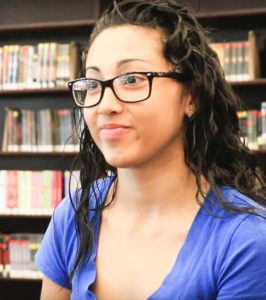Lorain County Community College President Marcia Ballinger explains her ideas about STEM and why she favors development of the NEOSTEM Ecosystem.
Why is STEM + C important for Northeast Ohio?
People have a lot to say about STEM + C and why it matters for our region and how they’re connecting to it.
Anthony Shaw, a student at the John Marshall School of Information Technology, said it’s a no-brainer to study information technology. “Technology is all around us and it’s changing every day.”
Ailin Zhu, a student at the John Marshall School of Information Technology, said animation has captivated her. “I like to try to make things grow. I try to do little things like a tried to make clouds move,” she said.
Marcia Ballinger, president of Lorain County Community College, said STEM+C has a long and great history in the region and is vital to its economic health. “I think one of the strengths of our region is our educational system and the commitment and the culture that we do have in place in Northeast Ohio, it’s powerful. And there is such strong work ethic, there is such a dynamic vision for what we can do together and so I think building off of that is tremendous.”

Katie Ayala pictured above.
Katie Ayala, a student at the John Marshall School of Information Technology, said technology is critical to master.
“People work with computers all of the time for everything. And they’re really powerful,” she said.
Ayala wants to become a doctor, with a specialty in obstetrics and gynecology and she said what she’s learning at the School of Information Technology should translate well. “We’re learning how to think logically,” she said. “And solve problems.”
For Chelsey Cook, principal of the new John Marshall School of Informational Technology, computer science represents a fantastic teaching tool. “Computer science takes math and science and incorporates this creativity and this big picture thinking that you so often find in a liberal arts curriculum…
Computer science really does offer teachers an opportunity to incorporate the liberal arts protocols and all of that deep dive thinking and abstraction if you will between the big picture idea constantly going down to the little details and how do those details affect the big picture and then incorporating the math concepts. “
Kingsten Lin, who completed his third-grade year in May 2016 at the Willoughby-Eastlake School of Innovation, said STEM has become a way of learning for him and he can’t imagine going back to a traditional classroom. “I need to be involved in experimenting…I like solving design challenges and interactive logic.”
Donald Braun, who spent 37 years working at NASA, volunteers at the John Marshall School of Informational Technology with the school’s NASA Club. Braun said computer science and STEM, in general, are empowering for students.
“You are the one telling the computer what to do and that is just awesome,” Braun said. “The No. 1 thing we have to do as educators, I believe, is to motivate kids. And STEM does that because it’s incredibly fun and hands-on and students are in charge.”
Brian Patrick, principal of the Willoughby School of Innovation, said STEM allows students to think differently. “We want our students to change the world and we’re giving them the tools to power the thinking that can make that happen,” he said.

Marcia Ballinger pictured above.
Marcia Ballinger, president of Lorain County Community College, said the principles of a STEM education, which center around asking questions, seeking answers and experimenting, are critical to a quality education and a healthy economy. We have so many assets that go back to the core of the strength of Northeast Ohio’s manufacturing heritage, building off of that, the innovation economy and now we’re in the gig economy and so within that gig economy we’ve got to recognize who our audience is, who our emerging entrepreneurs are, our emerging scientists and how do we support that and create the right culture, the right environment, the right ecosystem that encourages them to flourish? I believe the answer is in strengthening STEM education.”



